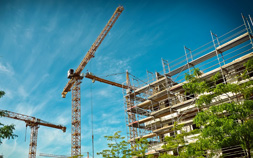Commercial Construction Special Report
by Marcus & Millichap | Commercial Real Estate Services
Published on April 24, 2020
SHARE POST

Pandemic Shrinks New Development Pipeline; A Modest Positive for Existing Real Estate Operators
Construction slowdown ripples across real estate sector. Construction delays and a pullback in project starts stemming from the spread of COVID-19 will offer existing operators a respite. Most major metros have suspended nonessential construction activity and placed stringent requirements on projects allowed to progress. These mandates will slow the number of apartment and commercial buildings finalized this year. Multifamily deliveries will trail initial annual forecasts by 15 to 20 percent, with between 240,000 to 260,000 units expected to enter lease-up. Office and retail supply additions may decline by a more substantive 20 to 40 percent, translating to the delivery of between 60 million to 80 million square feet of office space and 25 million to 35 million square feet of retail space. The industrial sector, which faces fewer headwinds than other property types, will likely finalize between 210 million and 260 million square feet this year. In addition to slowing the completion of projects already underway, the economic shutdown and more stringent lending climate will likely stall projects that are still in planning, mothballing many of them until the full recovery takes hold. The overall reduction in deliveries and starts will minimize the flow of competitive supply for an extended period, supporting tenant retention and leasing efforts at existing properties. While the reduction and delay of new competing space will be a boon to existing properties, operators will still need to contend with a softened demand outlook that will weigh on performance metrics.
Value-add strategies and redevelopment also delayed. While the brunt of construction suspensions will be borne by developers, investors in the process of renovating a property and those making significant tenant improvements will also be impacted. Placing nonessential construction work on hold will affect owners’ ability to upgrade properties and potentially slow tenants’ ability to move into space where tenant improvements are in process. If a project is exempt from stoppage under local regulations, property upgrades may still be vulnerable to significant delays. Most states now require construction projects to abide by a checklist of mandatory safety guidelines that require builders to stagger the number of workers on-site at a given time. This requirement, together with potential supply-chain delays, could dramatically slow delivery timelines and raise project costs. Investors planning to upgrade properties as the shelter-in-place guidelines are lifted can also expect delays stemming from a backlog of governmental processes such as permit issuance and inspection work that stacked up while government workers were out of the office.
Viability of proposed projects may be questionable. Encouraged by tight commercial vacancy rates across most major metros, developers had bolstered their pipelines prior to the onset of COVID-19. Many builders will need to reconsider the feasibility of projects that penciled at the beginning of the year but now face an entirely different market reality. The impact of ongoing project delays, a potential rise in construction costs, and a shift in the supply and demand outlooks will reshape project viability, causing many to be mothballed until a clear, positive outlook reemerges. Speculative developers and builders with hotel and multi-tenant retail proposals on the books are likely to avoid project starts. Multifamily builders will also recalibrate their models, reassessing whether upcoming supply additions will be met with sufficient demand. Most of these developers will likely either halt projects, at least temporarily, or scale projects down for a phased opening.
Some unique investment options could emerge. Merchant builders who would normally operate new projects through lease-up may choose to sell upon receipt of a certificate of occupancy, or even sooner. Given the prospect of an extended lease-up cycle, some builders may choose to forgo some of the upside potential and sell properties early to free up their capital. Well-capitalized investors willing to assume lease-up and potential construction risk may see unique assets emerge as a byproduct of the economic shutdown. Although some price discounting of these assets is likely, the large pool of prospective investors with significant dry powder could sustain a competitive bidding climate for well-positioned assets that come to market. Properties in markets with significant barriers to entry or robust historical demand will generate the strongest valuations. Properties in smaller tertiary markets or facing a more questionable outlook such as hotels and multi-tenant retail centers face a more challenging marketplace.
The information contained in this report was obtained from sources deemed to be reliable. Every effort was made to obtain accurate and complete information; however, no representation, warranty or guaranty, express or implied, may be made as to the accuracy or reliability of the information contained herein. This is not intended to bea forecast of future events and this is not a guaranty regarding a future event. This is not intended to provide specific investment advice and should not be considered as investment advice.
For Latest Updates